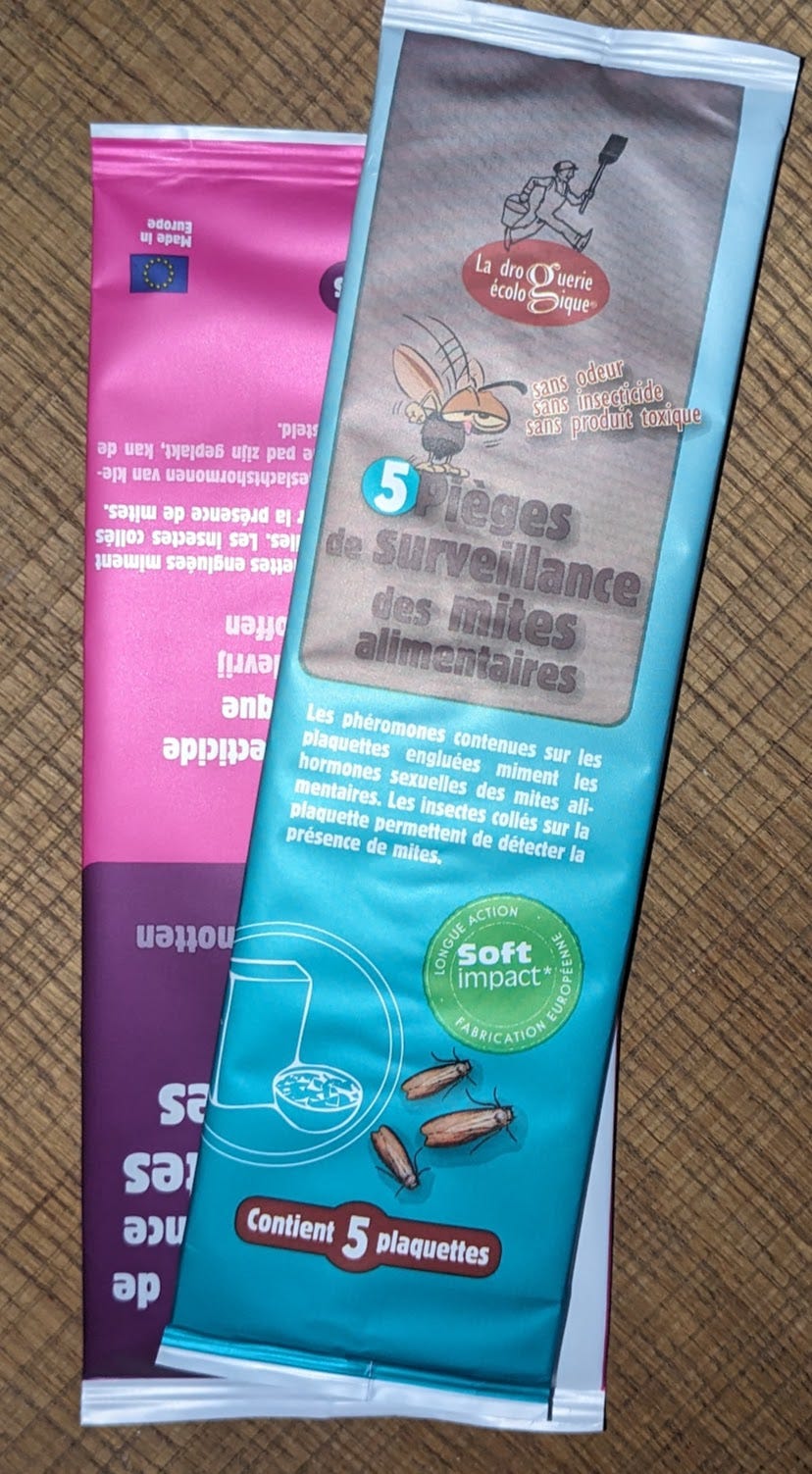The smallest possible button
Traps
I was shopping for moth traps earlier today, and it struck me how ruthlessly efficient humans could be in designing their killing apparatus. The weapon in question was a thin pack in my hands containing just a single strip of paper which, when coated with a particular substance and folded in the right way, would end up killing most of the moths in my house. No need to physically hunt them down or even pay remote attention to them myself; a couple bucks spent on this paper and a minute to set it up, and three quarters of the entire population is decimated in less than a day.
That’s… horrifying.
Moth traps are made from cardboard coated with glue and female moth pheromones. Adult males are attracted to the pheromones, and end up getting stuck to the sides where they end up dying.1 The females live, but without the males, no new larvae are born and in a few months time you’ve wiped out a whole generation of moths.2 These traps are “highly sensitive” meaning that they will comb a whole room of moths very quickly despite being passive in nature.
Why are moth traps so effective? They use surgically precise knowledge. Humans know how to synthesize moth pheromones, and from there you can hack a 250-million-year-old genetically derived instinct that male moths have developed for mating, and then you set a trap and voilà. The genetic heuristic that worked 99% of the time for boosting reproductive rates in moths can be wielded against moths by obliterating their reproductive rates.
Moth traps aren’t even the pinnacle of human insecticidal war machines. Scientists have, after all, seriously considered using gene drives to eliminate an entire species of mosquitoes with a single swarm and some CRISPy cleverness.3
The smallest button
Moth traps and gene drives work by understanding something so well that when you use brute force (because everything is brute force) to do something, you do it in the most optimal and surgical way. Intelligent design means humans can engineer very, very effective traps that harness the smallest buttons you can push in order to get a desired result.
Evolution can also produce sexually deceptive traps that take advantage of insect brains. This is because genes that contribute to pushing a particular button that makes reproduction more likely, are more represented in the environment, so most genes in living beings today are already vetted for their capacity to harness niche buttons in the universe.
The blind idiot god can’t hope to compete with intelligent design however, so we can expect humans to win the find-the-smallest-button arms race against their evolution-derived enemies (like moths, mosquitoes, or viruses).
Brute force
Brute force always works. If you stuff enough moths into my house, my measly passive traps won’t be sufficient. In fact, if my house were big enough and there were enough moths, the males that were somehow not attracted to my sticky female pheromones but found females anyway would be the only ones to pass down their genes. With enough moths and enough time, the blind idiot god of moth evolution would find a way to elude my traps by pressing an alternate small button to those specific pheromones, in order to power its reproduction. This type of brute force, which grants a stupid and blind enemy the power of adaptation, can be found in battles with cancer, viruses, or pesticides.4 The only counter to this brute force is more brute force, in the form of chemotherapy, gene drives, or pesticides 1 level of magnitude deadlier than the last. One fell swoop instead of targeted attacks.
Why is this important?
Being intelligent lets you engineer things. It lets you find the smallest buttons to press to bring about results, and often those buttons are insidious and lay on a whole other dimension than the ones your enemy operates on. Moths can’t understand “synthetic pheromones” and they can’t understand “I’m killing you because the vast fields of cloth you call food are my clothes, and I don’t want holes in them”. Individual moths cannot compete with my moth traps, and the only hope moth genes have of surviving in the long term involves brute force in the form of swarm-worthy numbers and long timescales.
Given how fast human progress is going, it won’t be long before we have more efficient moth traps that can respond to adaptation, or before we find a reliable “one fell swoop” solution (like gene drives for mosquitoes, chemotherapy for cancer, or mass vaccination for smallpox).
Moth traps operate on a dimension above individual moths. In turn, an artificial superintelligence would operate on a dimension above individual humans. Tiny buttons equivalent to “moth pheromones” would be available to it. One fell swoop solutions like “gene drives” would also be available to it. Humans are currently in the phase in between “moth traps” and “gene drives” in which they are not effectively omnipotent relative to moths, but they are very close. An AGI would bridge that gap much faster if only because transistors are faster than synapses.
It’s a pretty horrible way to die, too. When I checked in on the trap at some point, there were about a dozen moths there, all of them alive and squirming, wings permanently damaged with no hope of escape. Insect sentience is still up for debate but it’s still not very fun to watch.
Read more here. (The Wikipedia page ends with a hit list of insects that pheromone traps are effective with.)
The case for using this seems strong.
Cancerous cells that somehow evade your immune system (or chemotherapy rounds) survive to reproduce; viruses that bypass human vaccines survive to reproduce; insects that resist certain pesticides survive to reproduce.
Numbers and time are the weapons with which humanity’s unagenty enemies fight. (Evolution is kind of agenty and it is an emergent property of numbers and time. An emergent intelligence, if you will.)



